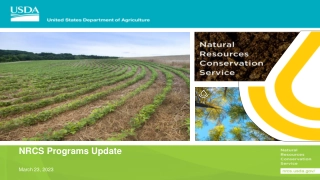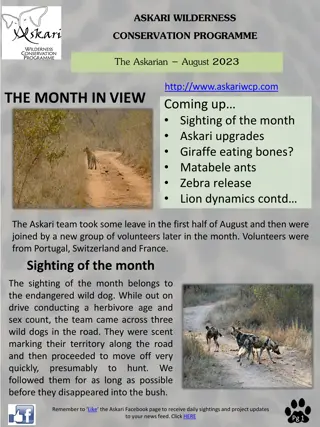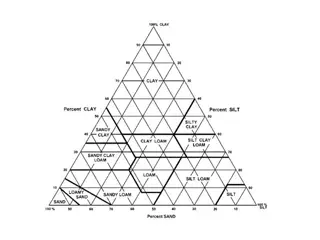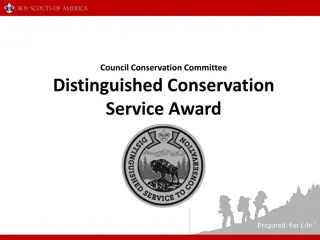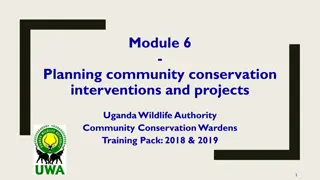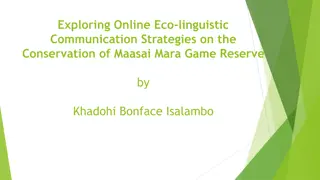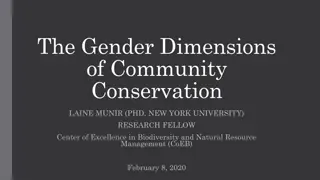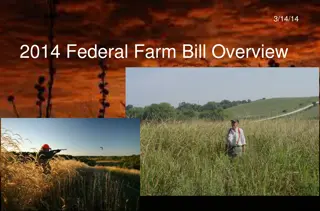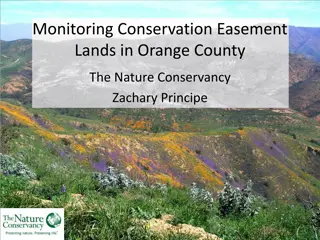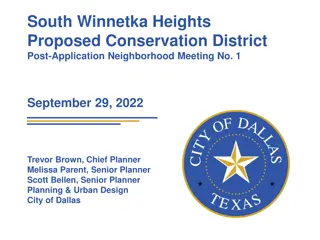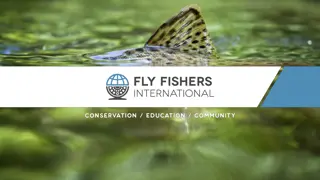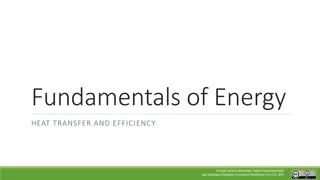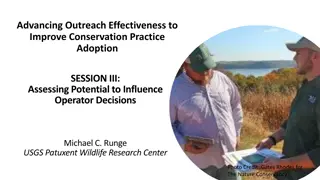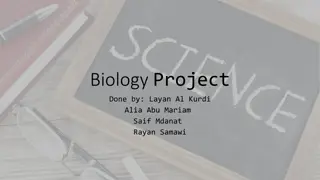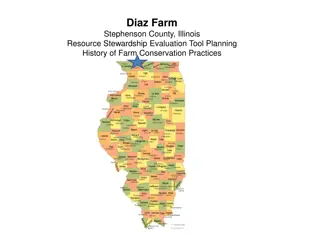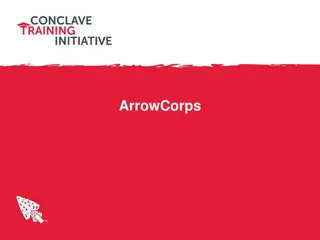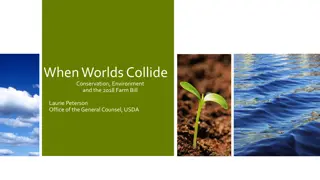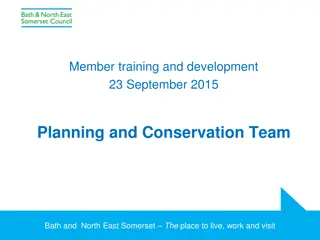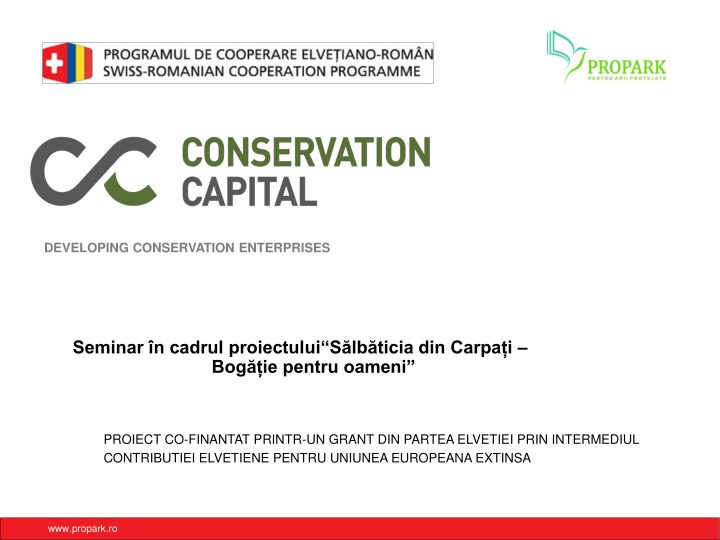
Developing Conservation Enterprises Seminar - ProPark Project in Carpathian Mountains
Join the Developing Conservation Enterprises Seminar within the ProPark project in the Carpathian Mountains. Explore conservation enterprise development, strategic benefits, industry sectors, and more. Gain insights into the European and Carpathian landscape for conservation enterprise. Discover the impact and success of conservation initiatives in Africa and Europe. Visit www.propark.ro for more information.
Download Presentation

Please find below an Image/Link to download the presentation.
The content on the website is provided AS IS for your information and personal use only. It may not be sold, licensed, or shared on other websites without obtaining consent from the author. If you encounter any issues during the download, it is possible that the publisher has removed the file from their server.
You are allowed to download the files provided on this website for personal or commercial use, subject to the condition that they are used lawfully. All files are the property of their respective owners.
The content on the website is provided AS IS for your information and personal use only. It may not be sold, licensed, or shared on other websites without obtaining consent from the author.
E N D
Presentation Transcript
DEVELOPING CONSERVATION ENTERPRISES Seminar n cadrul proiectului S lb ticia din Carpa i Bog ie pentru oameni PROIECT CO-FINANTAT PRINTR-UN GRANT DIN PARTEA ELVETIEI PRIN INTERMEDIUL CONTRIBUTIEI ELVETIENE PENTRU UNIUNEA EUROPEANA EXTINSA www.propark.ro
AGENDA Introductions & Goals Conservation enterprise: definition Conservation enterprise: conservation outcomes Conservation enterprise: strategic benefits Key industry sectors Conservation covenants www.propark.ro
Conservation enterprise: the development process Establishing contextual relevance Establishing commercial viability Building conservation linkages Optimising capital structures Managing execution fundamentals Grant versus investment financing Detailed business planning process The European & Carpathian landscape for conservation enterprise Next steps / needs: discussion www.propark.ro
Founded 2004 (10+ years) 25+ countries (Africa, Europe ) US$ 220+ million investment finance mobilised and structured (60% conservancy development, 40% direct enterprise investment) 75+ enterprises (all going concerns): - 60%: conservation tourism sector - 40%: food production, residential property, bio- enterprise Strong focus on conservancy development - 20+ (both private and community based) Diverse partner / client base: - 50% private sector - 30% NGOs - 20% public sector Diverse contexts: - 40% private conservation initiatives - 30% local community based - 30% public protected areas US$ 40 million annual commercial revenues US$ 6 million of direct annual cash flow support to conservation First ever conservation enterprise investment entity in Africa (African Wildlife Capital) First ever conservation enterprise investment entity in Europe (Rewilding Europe Capital) 5,000 jobs 100,000 new outgrowers engaged 10,000 s of households economically benefiting 100,000 s Ha DIRECTLY SUPPORTED 4 www.propark.ro
More about you? www.propark.ro
RELEVANCE A 2014 study produced by Credit Suisse, WWF and McKinsey & Company ( Conservation Finance Moving beyond Donor Funding towards an Investor-Driven Approach ) has suggested that the current gap between available supply of funding for conservation (c. US$ 40 billion of aid and charity and US$ 10 billion of investment) and actual need is at a staggering magnitude of US$250- 350 billion per annum www.propark.ro
CONSERVATION ENTERPRISE: A DEFINITION ? www.propark.ro
CONSERVATION ENTERPRISE: A DEFINITION Any commercial venture that generates economic and social benefits in ways that actively supports meaningful conservation outcomes in high value conservation landscapes www.propark.ro
CONSERVATION OUTCOMES ? www.propark.ro
CONSERVATION OUTCOMES: GENERATING FINANCE 1. Generating Finance: for example via user rights or entry fee revenues that directly support the development or management of a conservation area or initiative; www.propark.ro
CONSERVATION OUTCOMES: BUILDING INCENTIVES 1. Generating Finance: for example via user rights or entry fee revenues that directly support the development or management of a conservation area or initiative; 2. Building Incentives: by creating or increasing ownership of nature-based revenue flows to relevant stakeholders (typically local communities or public sector agencies) to increase associated conservation incentives; www.propark.ro
CONSERVATION OUTCOMES: OPTIMISING SUSTAINABILITY 1. Generating Finance: for example via user rights or entry fee revenues that directly support the development or management of a conservation area or initiative; 2. Building Incentives: by creating or increasing ownership of nature-based revenue flows to relevant stakeholders (typically local communities or public sector agencies) to increase associated conservation incentives; 3. Optimising Sustainability: by deploying or promoting sustainable alternatives to damaging commercial or livelihood activities that threaten critical natural assets; www.propark.ro
CONSERVATION OUTCOMES: REDUCING ENCROACHMENT 1. Generating Finance: for example via user rights or entry fee revenues that directly support the development or management of a conservation area or initiative; 2. Building Incentives: by creating or increasing ownership of nature-based revenue flows to relevant stakeholders (typically local communities or public sector agencies) to increase associated conservation incentives; 3. Optimising Sustainability: by deploying or promoting sustainable alternatives to damaging commercial or livelihood activities that threaten critical natural assets; 4. Reducing Encroachment: by increasing the economic productivity of buffer areas to reduce the need for encroachment into core conservation landscapes; www.propark.ro
CONSERVATION OUTCOMES: STIMULATING ENGAGEMENT 1. Generating Finance: for example via user rights or entry fee revenues that directly support the development or management of a conservation area or initiative; 2. Building Incentives: by creating or increasing ownership of nature-based revenue flows to relevant stakeholders (typically local communities or public sector agencies) to increase associated conservation incentives; 3. Optimising Sustainability: by deploying or promoting sustainable alternatives to damaging commercial or livelihood activities that threaten critical natural assets; 4. Reducing Encroachment: by increasing the economic productivity of buffer areas to reduce the need for encroachment into core conservation landscapes; 5. Stimulating Engagement: by facilitating access to, and educational / inspirational experiences with nature that foster the increased engagement of relevant constituencies. www.propark.ro
CONSERVATION ENTEPRISES: STRATEGIC BENEFITS ? www.propark.ro
CONSERVATION ENTEPRISES: STRATEGIC BENEFITS 1. CONSERVATION OUTCOMES! 1. Financial Sustainability: Their conservation outcomes can be generated on a sustainable basis by virtue of being supported by a commercial going- concern. www.propark.ro
CONSERVATION ENTEPRISES: STRATEGIC BENEFITS 1. CONSERVATION OUTCOMES! 1. Financial Sustainability: Their conservation outcomes can be generated on a sustainable basis by virtue of being supported by a commercial going- concern. 1. Funding Diversification: They can be funded with commercial investment capital that does not compete with the increasingly stretched public/philanthropic funding sources that have traditionally dominated the conservation development sector (see further below). 1. Promotion of Sustainable Values: Interaction with wide supplier and customer stakeholder base can make conservation enterprises effective distribution channels for promoting conservation messages and values. www.propark.ro
KEY INDUSTRY SECTORS ENERGY* TOURISM NTFP* AGRICULTURE HUNTING LIVESTOCK TECHNOLOGY* FISHERIES* RESIDENTIAL PROPERTY* www.propark.ro
1. ESTABLISHING CONTEXTUAL RELEVANCE Conservation CONTEXT - Values (C&P) - Threats (C&P) - Multiplier Potential - Property Rights - Policy Environment - Stakeholder Context Enterprise OUTCOMES - Generating Finance - Optimising Sustainability - Offsetting Encroachment - Building Incentives - Stimulating Engagement www.propark.ro
1. ESTABLISHING CONTEXTUAL RELEVANCE Conservation CONTEXT - Values (C&P) - Threats (C&P) - Multiplier Potential - Property Rights - Policy Environment - Stakeholder Context Enterprise OUTCOMES - Generating Finance - Optimising Sustainability - Offsetting Encroachment - Building Incentives - Stimulating Engagement www.propark.ro
2. ESTABLISHING COMMERCIAL VIABILITY Products Risk Markets Options + Viability Conservation Outcomes Fulfilment Policy & Regulatory Property Rights www.propark.ro
3. BUILDING CONSERVATION LINKAGES Conservation Covenants (Outcomes Drivers) Conservation Context Enterprise Context (Outcome Enablers) (Required Outcomes) www.propark.ro
4. OPTIMISING FINANCIAL STRUCTURES Driver 1: Conservation Context Driver 2: Driver 5: Risk Context Stakeholder Context Capital Structure Yield Structure Driver 3: Enterprise Context Driver 4: Capital Requirements www.propark.ro
5. MANAGING EXECUTION FUNDAMENTALS Business planning Property rights Financing Conservation covenants Partnership structures Operators www.propark.ro
CONSERVATION ENTEPRISES: GRANT V INVESTMENT APPROACH Long term financial relationships with underlying portfolio companies create an active and enduring engagement platform, and the leverage to optimise focus on both commercial and conservation performance; The investment dynamic captures and applies the positive power of risk for both financier, and the underlying investee; It enables the financier to re-orientate funding towards a demand-lead rather than the supply-lead dynamic so prevalent with international grant-based funding; It is enables engagement with existing, and hence de-risked, enterprises with high conservation potential, as well as the greenfield projects that tend to dominate grant providers attention; It creates the basis for a multiplier effect with the ability to recycle returns into multiple projects with multiple impacts over time; It eliminates the inherent market distortions created by free financing. www.propark.ro
CONSERVATION ENTEPRISES: BUSINESS PLANNING www.propark.ro
CONSERVATION ENTEPRISE: DISCUSSION THE EUROPEAN LANDSCAPE? THE CARPATHIAN LANDSCAPE? www.propark.ro
DISCUSSION: NEXT STEPS? www.propark.ro

